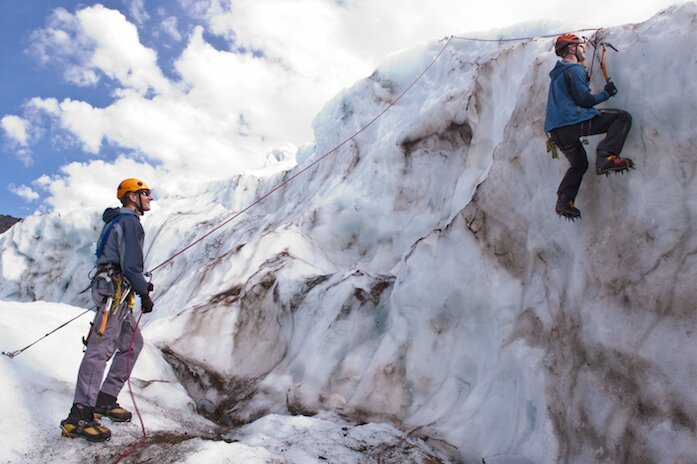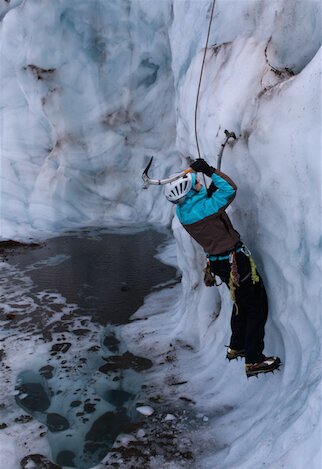 By Jason Martin
By Jason MartinAs the summer comes to a close in the Northwest, people start to think about winter. For most of us, autumn is the season when we do the least amount of recreation. It’s often rainy and there isn’t much snow yet, so we go to the gym and get outside on the odd clear day. Ironically though, the fall season provides the best conditions of the year for one mountain sport: Seracing.
A serac is an ice tower found in an icefall on a glacier. Seracing refers to the full gamut of low-commitment glacier ice climbing, including climbing out of crevasses, climbing natural bulges and ramps, as well as climbing seracs.
Seracing is also incredibly fun. It essentially takes all the things out of ice climbing that make people dislike the sport, and keeps everything that makes people fall in love with it.
You still get all the medieval-looking equipment and you still get to bash away at a climbing objective, but you get to do all that without subfreezing temperatures and chest-deep snow. Since temperatures are warmer than in mid-winter, the ice is consistently plastic – we call it “hero ice.”
Our own Mt. Baker hosts one of the most easily accessible glaciers with good seracing ice in the continental U.S. The Coleman glacier is only a little over 3 miles up a well-maintained trail, and the lower Coleman in particular provides an exceptional amount of terrain for beginner to advanced-level climbers.
Throughout much of the year the Coleman is covered with a thick blanket of snow, which often hides the best terrain for climbing while also obscuring dangerous crevasses. The summer heat melts the snow off the glacier to reveal thousands of possible ice climbs, but while the ice is climbable in the summer months, it’s often rotten and wet. In the fall, the cool autumn air keeps the ice plastic and fun.
Often when people think of icefalls, they think of the most infamous icefall in the world: the Khumbu icefall on Mt. Everest. The Khumbu is constantly moving and everything in it – from massive walls of ice to 10-story-tall ice towers – is in a never-ending state of collapse. Dozens of people have been killed there, crushed under falling ice.
The Coleman glacier is nothing like the Khumbu. The ice is moving, but at a much slower pace. The climber’s left-hand side of the Coleman icefall is significantly less stable than the climber’s right-hand side, but by avoiding the left side of the icefall and by making good decisions about where to climb, individuals can avoid most of the objective danger posed by the area.
There is one odd danger that climbers on the lower Coleman have to manage. It’s common for people to climb on the glacier when the temperature is well above freezing. When it’s warm enough, solar radiation tends to melt out ice screw anchors, even on cloudy days. This can happen in as little as 30 minutes, so it’s important to put snow or ice over screws to protect them from the sun and to check them regularly. Another option is to incorporate a “v-thread” into your anchor. These tend to last longer than ice screws.
There are three types of climbing that take place on the lower Coleman: crevasse climbing, icefall tours and classic seracing.
Crevasse Climbing
Many mountaineers lower themselves into crevasses to practice self-extraction or team-extraction rescue skills. However, the crevasses on the lower Coleman also offer an excellent opportunity for steep ice climbing practice while providing a serious forearm pump. With lines measuring over 100 feet long, lower Coleman crevasses consistently harbor some of the longest ice lines available in the area.
The best way to manage a crevasse climber is to build an anchor a short distance from the lip of the hole and then lower the climber in. The belay system you choose must easily convert from lowering mode into climbing mode. There are several ways to do this, but one simple option is to use a munter-hitch with an autoblock backup for the lower. When the climber starts back up, you can simply belay him up as he moves without changing anything.
When there is no snow on the glacier in the late summer and fall, the lower Coleman becomes a “dry glacier.” You can see where all the crevasses are, so there is no need to rope up when you get onto the glacier in order to manage crevasse hazards. However, if you intend to poke around at the edge of a crevasse in order to find a good spot to climb, you should definitely rope up for
security.
Icefall Tours
An icefall tour is exactly what it sounds like – a tour of the icefall – and icefall tours are awesome!
A good icefall tour encompasses a number of different ice climbing and mountain travel skills. One can boulder up short hard objectives, lead climb random lines and rappel down into large open crevasses that you can easily climb out of. The goal of an icefall tour is to explore and to move through the icefall without stopping to change up what you’re doing too much; all in order to experience the beauty and glory of the place.
While travel on a dry glacier doesn’t require a rope, an icefall tour usually does. It also requires a leader who has good mountain sense and can actively lead steep pitches of ice. Without these two things it would be easy for a team to get stuck, lost or injured in the icefall.

Classic Seracing
The most common ice climbing practice on the lower Coleman is for a team to show up, scout the icefall for awhile and then find a nice ice cliff to set up. Most teams set up top ropes, but occasionally people lead.
If you intend to serac at one or two areas throughout the day, it’s important to ensure that the places you choose are safe from objective danger. The most obvious danger is falling ice, but occasionally there are deep open crevasses or even deep pools of water next to good ice cliffs. When choosing a climbing site, make sure there isn’t a lot of debris around, as this could be a sign of instability up above. It’s also important to make sure that the feature you intend to climb is secure. There’s no surefire way to know if something is going to collapse or not, but if there are cracks above or if the feature appears to be leaning over, it’s probably not a good idea to climb on it.
Mt. Baker is a very special mountain. Every season, it has something to offer. We ski in the winter and spring. We hike and climb the mountain in the summer; and in the fall, we serac.
What more could you ask for?
How to get there:
Drive up Mt. Baker Highway to the town of Glacier. On the east end of town, just before you reach Chair 9, turn right onto Glacier Creek Road. Drive 8 miles up the road to the Heliotrope Ridge Trailhead (Northwest Forest Pass required).
Hike up the Heliotrope Ridge trail for approximately 3 miles. When you reach the junction with the sign that says, “Climber’s Route,” go left. Do not go up the climber’s route. Continue for 10 minutes to the ridgeline and viewpoint above the Coleman glacier.
To access the glacier, drop down the heavily treed ridge and into the flat camping area affectionately referred to as Mirkwood by American Alpine Institute guides (elevation: 5,000 feet or 1,524 meters). Just below the lowest camp, a steep trail just left of a muddy gully descends down through the woods and onto the terminus of the glacier.
Don’t have the skills to set up a Coleman ice climbing trip yourself? Contact the American Alpine Institute at 360/671-1505 or by email at info@alpineinstitute.com. x